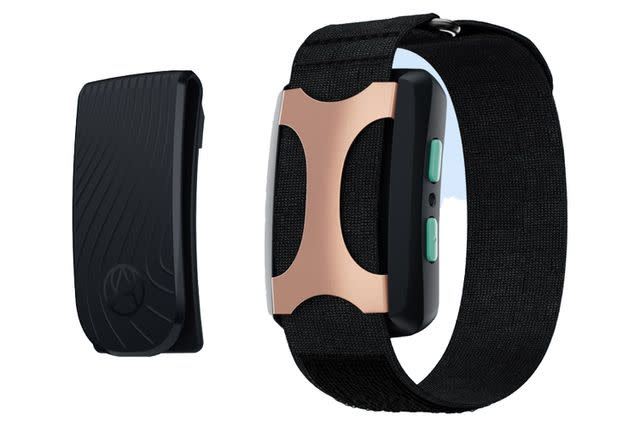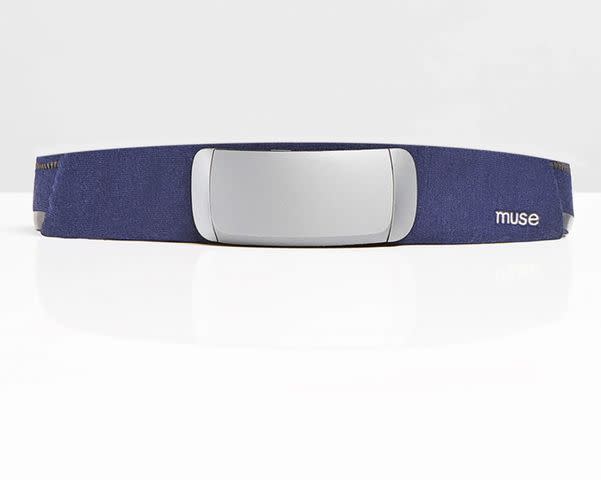How Technology Can Help Reduce Your Stress (Really!)
Stop the doom-scrolling and try these tech tools to help you reduce your stress.

Oura Ring
Laid-back and relaxed have never been words used to describe me. But even though my default setting is generally "amped-up," recently I've gotten a lot closer to an actual short circuit, as stress has threatened to overwhelm my normally can-do spirit.
So I've been trying to find ways to connect with my calmer side. The challenge? I tend toward dramatic eye-rolling at the thought of spending 20 minutes just breathing and "connecting with my inner self." (I'm in touch with my inner self enough to know that she doesn't have a lot of patience for that.)
Sure, tech generally tends to actually cause stress, rather than solve it. And anyone who's been doom-scrolling at 3 a.m. (ahem, me) will definitely get that.
I've already been using some stress-relieving tech techniques, like limiting social media app use and adjusting my smart bulbs to more low-key light settings as the day goes on. But I still found myself low on sleep, low on patience, and too high on adrenaline.
Related:Tech Tips for Meeting Your Life Goals
So I brought in the big guns. I test-drove a few of the most popular (and most intriguing) mindful and stress wearables to see if I could find more pockets of zen in my day.
Apple Watch

Apple
Apple Watch Series 7Fitness tracker apps like Apple Watch have been uber-popular to help to get people up and at 'em. I've been a long-term user, who always pushes to meet the goals (even if that means a few before-bed jumping jacks or stair climbs to close my rings).
The Watch collects a fair amount of health data, including trends in your heart rate, cardio fitness, and more, which you can use to get a sense of your overall health (and encourage you to do something about it).
The Apple Watch's Mindfulness tools are a bit more basic, with just two options: Reflect and Breathe. Reflect gives you a minute to ponder a zen-inducing prompt (like "think about a time when you helped someone"), while a soothing lava-lamp animation plays on your watch face. Breathe uses haptic tapping to encourage you to breathe deeply for a minute while an animated circle opens and closes. I didn't find either of them especially soothing–and my heart rate and stress levels never dropped.
The meditations available in Apple's Fitness Plus were a bit more involved (and longer), often with gentle movement or stretching included—which is probably a good thing if you've been stuck behind a desk all day. I liked the more active approach, but you'll need an extra subscription to access them.
Related:5 Completely Free Meditation Apps to Help Center Your Mind
Bottom line: If you're looking to improve overall fitness and health to help reduce your stress, this could be the tech for you. But it's not exactly stellar at helping reduce stress levels (at least, not yet).
To buy: From $249, apple.com
Oura Ring

The Oura ring has been a popular pick for wearable health tech, thanks to its ability to track more than a dozen different pieces of data about your sleep, fitness, and other health markers. It has a much longer battery life than most smartwatches and fitness bands. (With up to seven days between charges, and just a few minutes to recharge, it's much easier to keep working than an Apple Watch, for instance.)
The Oura can help you see where you might need some work for better health, whether it's getting more active or getting more sleep. And it did a much better job than my Apple Watch of encouraging me to get enough shut-eye in particular, by showing me exactly how it impacted my energy levels and "readiness" to take on the next day when I stayed up past midnight.
The app offers a series of different meditations to help you with everything from being more creative to calming your mind, to (of course) lulling you to sleep. Fortunately, most of the non-sleep meditations are blissfully short (under five minutes!) so even the meditation-averse may be willing to give them a try. And there's also a series of articles to help you optimize your sleep and boost your numbers.
Related:9 Short, Calming Breathing Exercises for Anxiety Relief
After using it for a few weeks, I found that I was getting much better at meeting sleep goals (and hitting that 11 p.m. bedtime Oura suggested for me), and achieving more days where I was declared more than ready to face the day.
Bottom line: The ring's data can really give you a sense of where you can make lifestyle changes to improve your stress levels, and the numbers and trends can encourage goal-oriented people toward success. The long battery life and easy all-day wear make it something you're inclined to use, rather than leave on your nightstand.
Related:Wearable Sleep Trackers Might Be Worth the Hype, Experts Say—Here Are Their Favorites
The short-and-sweet meditations would be easy to work into your day, though you can't set up the app to prompt you to start one—and I didn't find myself reaching for the phone to do it.
To buy: From $299, ouraring.com
Apollo Neuro

Apollo
The Neuro was a super-easy addition to my day. Just wear the tech (either on a band on your wrist or ankle, or a clip on your waistband or bra strap) and let it literally vibe you into the mood you're seeking, whether it's soothing you to sleep or helping you feel more at ease when you're socializing.
The science behind it: The Neuro uses your skin's touch receptors to reset your emotional cortex to the state you want, whether it's focused for work, energized for a workout, or calm for winding down at the end of the day. They recommend using it for at least three hours a day, five days a week, to get the optimal benefit. And the stats they cite are pretty impressive—a 40 percent decrease in stress and anxiety, and an 11 percent increase in heart rate variability (HRV). (Low HRV is associated with being stressed.)
When the Neuro is working, it feels a bit like having a purring cat tapping out Morse code against your wrist or waistband. Noticeable here and there, but after a while, you forget it's happening.
You can program your Neuro to start up automatically at certain times—like using it to gently wake you up in the morning with the vibrations (especially nice if you have a partner in bed next to you who likes to sleep in). And if you're feeling a bit blah in the moment, you can just tap into the app to choose a program that suits the vibe you're looking for, whether it's meditation and mindfulness, social and open, or rebuild and recover. You can also adjust the intensity and length of the program there, if you need the vibrations to keep going or just want a short burst to get you there.
I adored the fact that I didn't have to carve out time to use it, or listen to someone talking about breathing and waves and silence. It was a set-it-and-forget-it stress-relieving tool. I found myself using Neuro several times a day, especially when I was looking to shift gears, whether it was getting out of bed, getting focused for work, or winding down at the end of the day. My favorite setting: Clear and Focused, which kept me on track when I was writing and even seemed to help stop a headache that was brewing.
Bottom line: If you don't have a lot of time to devote to reducing stress (and honestly, if you're super stressed, odds are you don't), this tech tool definitely seemed to help change my mood and chill me out, no effort required.
To buy: $349, apolloneuro.com
Muse

Muse
Muse bands are worn on your head, not your wrist, to tap into your brain waves like an EEG—alongside the typical wellness data like heart rate and breathing. By measuring how active your brain is, it can adjust the meditation by changing the background sounds to help you stay on target and on meditation.
There are two types, the Muse 2, which looks like a bone-conduction headset and is just used for waking meditations; and the Muse S, which uses a soft band so you can wear it to bed and track your sleep.
Not going to lie, wearing the band made me look like I was an Star Wars extra, and I struggled a bit to get the band to sit where it needed to be. (The app runs a sensor test before you start each meditation to make sure you have it in the proper place.)
The meditations ranged from my favorite short-and-sweet options to longer explorations, and you can choose the background sound they use to keep you focused, from options like rainfall, white noise, and bells.
Muse offers more than a dozen basic meditations (plus a slew of sleep-focused programs) for free, but there are hundreds of targeted sessions that you can unlock with a $95 yearly subscription. (Think multi-meditation programs dedicated to life stages like parents or college students, health issues like cancer or fertility, goals like focus or creativity, and of course, straight up looking for more gratitude and joy or less stress and burnout in your life.)
They turn meditation into a bit of a game, awarding you birds when you're calm, points for every second you meditate, and gold stars when you stay focused on the meditation. That may be just the psychological trick to keep type A types tuning in (and tuning out) for more meditations.
The sleep tracking is just as robust as the Oura's stats, with info on how long and deeply you slept, when you hit various sleep states—and even how much time you spent in different sleep positions through the night. (Apparently, I'm very big on my right side.)
But the Muse is definitely not the kind of thing you're probably going to put on to chill out in your office cube or commute, so you'll need to carve out time to use it beyond the bedroom for sleep.
Bottom line: If you're serious about meditation and improving your practice, this may be just the tech tool for helping you focus and reduce your stress. The focused meditations can be really helpful if you have a very specific issue you'd like to work out with meditation.
But you'll likely have to make a conscious effort to work this into your life, as this isn't something you'll be wearing out and about.
To buy: From $250, choosemuse.com
For more Real Simple news, make sure to sign up for our newsletter!
Read the original article on Real Simple.
